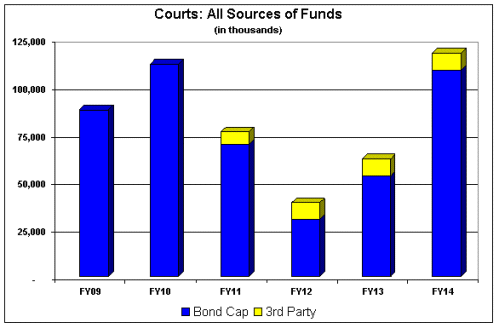Quick Links
- Report
- Introduction
- Accomplishments & Initiatives
- American Recovery and Reinvestment Act of 2009
- Development of the FY10-14 Capital Investment Plan
- Affordability & Fiscal Responsibility
- Aggregate FY10-14 Capital Investment Plan
- Capital Investments by Investment Category
- Appendix A - Debt Affordability Analysis
- Appendix B - Bond Bills
- Appendix C - Project Listing (xls)
- Appendix D - Project Descriptions (pdf)
- Plan by Investment
- Plan by Capital Agency
- Plan by Beneficiary Agency
- Downloads
- Site Map
Courts
The Commonwealth operates 61 court facilities, almost 5 million gross square feet of space, in 39 communities across the state. The Massachusetts Trial Court system also includes 23 county-owned courts and 34 other facilities. Capital spending for judiciary projects is administered through DCAM, which has spent approximately $487 million on courts projects over the past five years, 37% of its total capital spending. Continued investment is necessary not only for the effectiveness of court operations, but also for the health and safety of court staff and members of the public who participate in the judicial system. DCAM is managing several new court construction projects, including construction of new facilities in Fall River, Salem and Taunton. In addition, demolition has begun in preparation for construction of a new courthouse in Lowell.
The following chart shows projected FY09 spending and the Administration’s expected five-year capital investments in courts. Lower spending in fiscal years 2011 and 2012 reflect the completion of the three major court projects currently underway and the initiation of the next wave of court projects, including projects in Greenfield and Lowell.

Fiscal year 2010 highlights include continued investment in the major projects underway, including:
$26 million for completion of construction of the new $85 million District and Superior court facility in Fall River;
$30.4 million for construction of the new $106 million courthouse in Salem,
$33.2 million for construction of the new $86 million Taunton Trial court facility.
The Administration obtained authorization to sell certain court facilities that may be or that are expected to be replaced by new court facilities and to apply the proceeds of the sale to help offset the costs of the new replacement court project. The Administration sought this authorization and will use it to help stretch its limited bond funds for court projects to invest in as many court projects as possible. For example, the Administration has determined that the sale of the Edward J. Sullivan Courthouse in Cambridge may be the most cost effective way for the Commonwealth to deal with the asbestos and other issues with the property. Proceeds of the sale would be applied to fund temporary costs of relocation before a permanent solution is developed.
 top of page
top of page